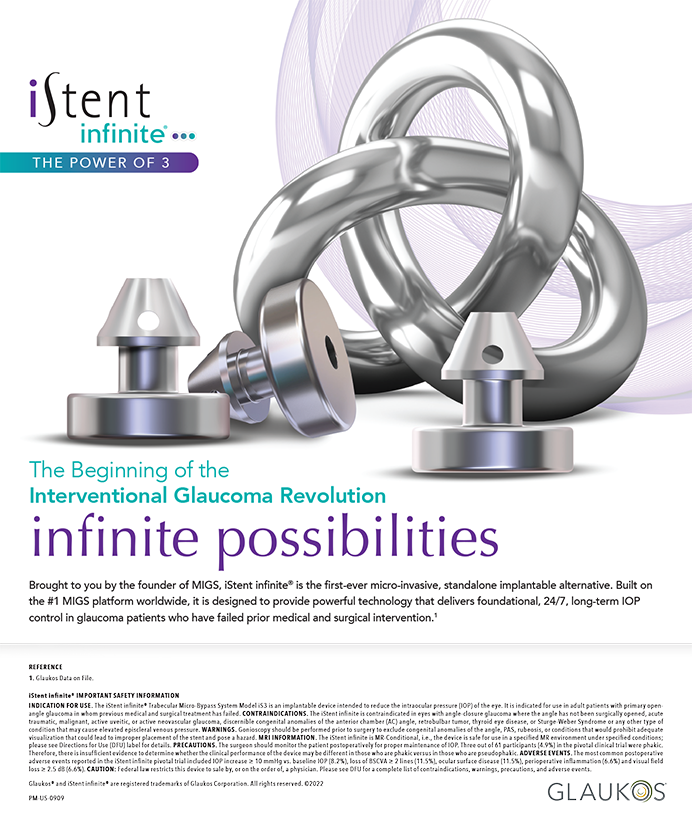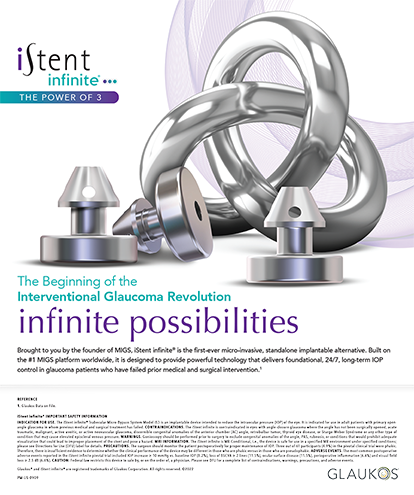The purpose of this study was to determine whether conductive keratoplastySM (CKSM) is a suitable treatment for inducing monovision in patients in the hyperopic presbyopic age group. This is a continuation of the clinical studies that have been conducted for FDA approval for hyperopic treatment with CKSM, which received approval status in December 2001. Refractec (Irvine, CA) expects CKSM to become commercially available in the US in February or March of 2002; it is already commercially available internationally.
CKSM IN THE CLINICAL SETTING
In addition to treating low levels of hyperopia, CKSM can be used to induce myopia and correct astigmatism. It can be an alternative for patients who haven't had viable treatment options in the past, such as those with excellent distance vision, but who need reading glasses. Although we can perform hyperopic LASIK or hyperopic PRK on these patients, surgeons have been a little reluctant to perform surgery on 20/20 eyes, because of the invasiveness of the procedure. CKSM, on the other hand, does not remove tissue, does not involve cutting, does not cause dry eyes, is conducive to retreatments, is less expensive than LASIK, and can be performed right in the office. It also targets a whole new population of presbyopes.
APPEALING TO THE CONSUMER
In the US, we've spent the last 30 years convincing myopes that they can undergo corrective surgery such as RK, PRK, and keratophakia, and recently LASIK. However, when we offer CKSM to the community, patients say that they didn't know anything could be done to eliminate reading glasses. When we ran an ad in our Kansas City newspaper about this clinical trial, 500 people called and said that they really liked the idea of a procedure that does not involve a laser and does not cut the cornea. CKSM could therefore be a viable option for these patients. It has been our observation that CKSM tends to provide better reading vision than expected for the amount of myopia induced.
THE STUDY
The target in this study was to leave one eye at plano and correct the other eye to -1.0 to -1.25 D. This degree of anisometropia is tolerated very well. There were 32 eyes in the study, and we were allowed to include patients who were hyperopic. The binocular distance vision was excellent; 95% of the patients could see 20/20 at distance. Uncorrected near vision was J1 in 38% of patients at 3 months, and J3 in 94%, which is the approximate level at which people can start reading without glasses. We also saw 88% accuracy within +/ -0.5 D, which is very high. There were some overcorrections and some undercorrections, although very few—one patient was undercorrected at 1 month, and there were no undercorrections by 3 months. Although one patient was overcorrected, that person remained very satisfied.
DIFFERENCES FROM LTK™
Two aspects differ dramatically between CKSM and LTK™: (1) CKSM appears to have better stability, and (2) CKSM produces smaller initial overcorrections. LTK™ can produce a large overcorrection before it regresses. My average LTK™ refraction at 1 week is -2.0 D in a matched set of patients, where this CKSM group was -0.65 D, so the CKSM patients were much happier in the early postoperative period than LTK™ patients. Regression with CKSM appears to be superior as well, with 91% showing +/-1 D at 1 year.
STABILITY
CKSM met the FDA criteria for stability even at the 3-month level. There was some induced astigmatism at 1 month that was improved at 3 months, but we find this is typical with any procedure that is conducted symmetrically in the peripheral cornea. After receiving FDA approval, surgeons will probably just add a spot in the area of the astigmatism to correct it, and it could actually be completed right at the slit lamp. I do not think induced astigmatism will be a significant problem for CK;SM LTK™ only allows physicians to apply eight spots at a time, but CKSM gives them the flexibility of being able to apply only one.
INFORMING YOUR PATIENTS
It is important to understand that hyperopia increases with age, as does presbyopia. Therefore, I expect all patients who undergo CKSM to eventually need a secondary procedure to maintain their reading vision. I inform all of my hyperopic patients that they will require future retreatment. This is a different type of patient consultation from myopes, because all hyperopic procedures, not just CK,SM will require enhancements eventually. I try to compare it to botox injections, in which both the doctor and the patient understand that the patient may need another treatment down the road. Hyperopic and presbyopic patients will also require a retreatment at some point, but it does not mean that they are unhappy about not needing reading glasses. If these patients eliminate reading glasses for 2 years and then have to have a minor touch-up procedure a few years later, CKSM is well suited to that type of retreatment. My final point is that CKSM is easy to perform, is very safe, and produces happy patients, but physicians should be careful not to oversell it.
Text extracted from Dr. Durrie's presentation, “Conductive KeratoplastySM for the Treatment of Presbyopia,” hosted by Refractec and presented on November 12, 2001 at the AAO Meeting in New Orleans, Louisiana.


